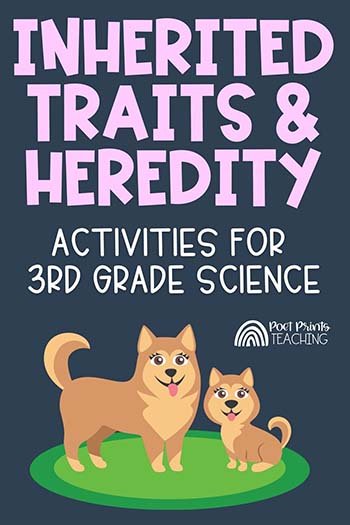Inherited Traits and Heredity - 3rd Grade Science
Did you ever play those games growing up where you had to look at a group of pictures and identify what’s different? I think the phrase “One of these is not like the others” was commonly used in these games. I can’t help but think about this phrase when it comes to learning about inherited traits in plants and animals. I think this is such a fun topic to teach students because it really gets them to use their observation skills. So let’s take a look at some engaging activities for teaching third graders about inherited traits in plants and animals.
What Is An Inherited Trait?
An inherited trait is a trait that is passed down to the offspring from its parents. These are traits that the animal has from birth. Some examples are eye color, patterns on the fur, fur color and length of legs. In plants, there are still two parent plants, even though plants don’t mate. Pollen from one plant travels to another plant, by wind or by animals carrying the pollen. That plant then grows seeds, which become the offspring of the plant. Some inherited traits in plants are seed color, seed shape, leaf shape, height and root shape. Now that we have a better understanding of what inherited traits are in plants and animals, let’s look at some activities to teach third graders about them.
A note to teachers: I try to be mindful when teaching about inherited traits, as the concept of human inherited traits can be a trauma trigger for many students. There are many family situations where inherited traits and genetics simply cannot be known by the student. The question “What traits did you inherit from your parents?” may seem innocuous, but could be hurtful for many different family situations. The NGSS standard about inherited traits is also “limited to non-human examples” - so we don’t have to worry about addressing that piece at all!
Plan Your Inherited Traits Lesson with One Click
Looking for a FAST way to plan out your fossils unit that already includes paired nonfiction passages? In just a few clicks you can grab all of the pieces you need: lesson plans, paired passages, reading comprehension, key reading skills, and a fun STEM challenge! Click and print. Planning is really that easy.
Read Informational Text
Two paired informational text passages about inherited traits. Grab them here!
If you’ve been around here for any length of time, you know that I’m a huge fan of paired information passages. This really gives students the knowledge and vocabulary for further exploration of a topic.
In this set of inherited traits paired passages, students will read about why animals look like their parents and they’ll read about whether or not plants have parents. Through these texts, students will learn about the inherited traits in plants and animals. Then, we move on to some reading comprehension that helps to let me know how much students have understood.
zoo field trip
This is the perfect topic to head out for a field trip to the zoo, especially if you end up teaching this unit around the time when the animals are giving birth to their babies. How amazing would it be to visit real animals and observe their inherited traits?
Can’t head out on a field trip? No Problem! There are so many options for virtual zoo field trips. In Canada, the Toronto Zoo offers a virtual field trip. For our friends in the states, this is a great round up of some of the virtual ways your students can see live animals from your own classroom!
sculpt or draw inherited traits
If you have students who love art, then this activity is the perfect way to combine art with science. First, have students read about some characteristics of two parent animals. This might be in some information passages or it could be on cards of paper, like the ones pictured!
Then have students use playdough to sculpt what they think the offspring would look like. If you don’t want to use playdough, students can also use paper to draw what they think the offspring would look like.
inherited traits videos
YouTube is also a great resource, but keep in mind that a lot of videos about inherited traits do talk about inherited traits in humans. While doing a deep diving into the world of YouTube to find videos free from this, I found this cute video that has students looking at parent animals and baby animals. However, the last slide of the video does ask “How are you similar to your parents?”





